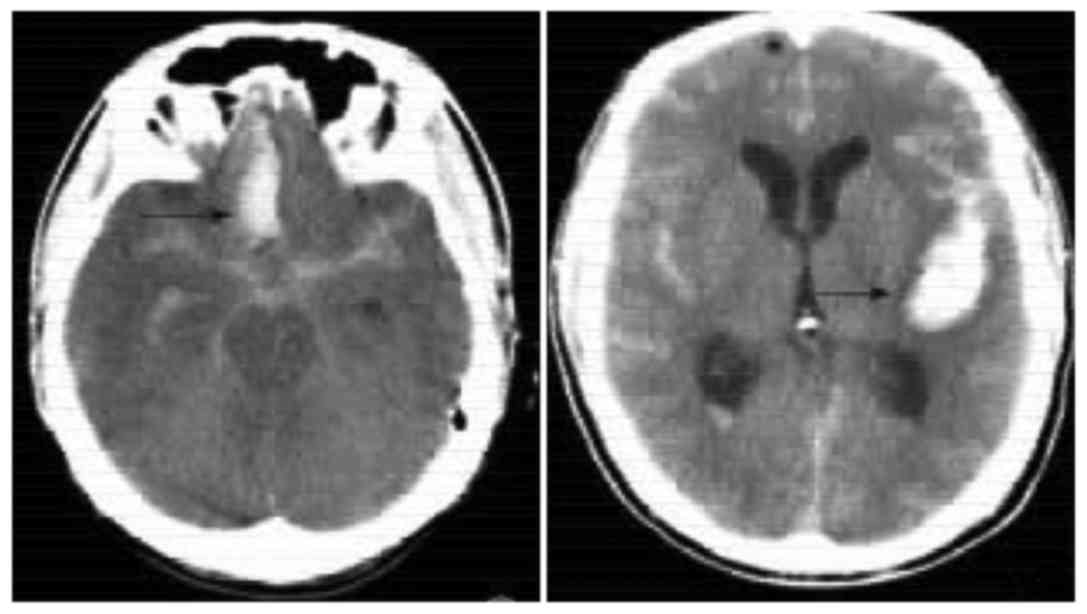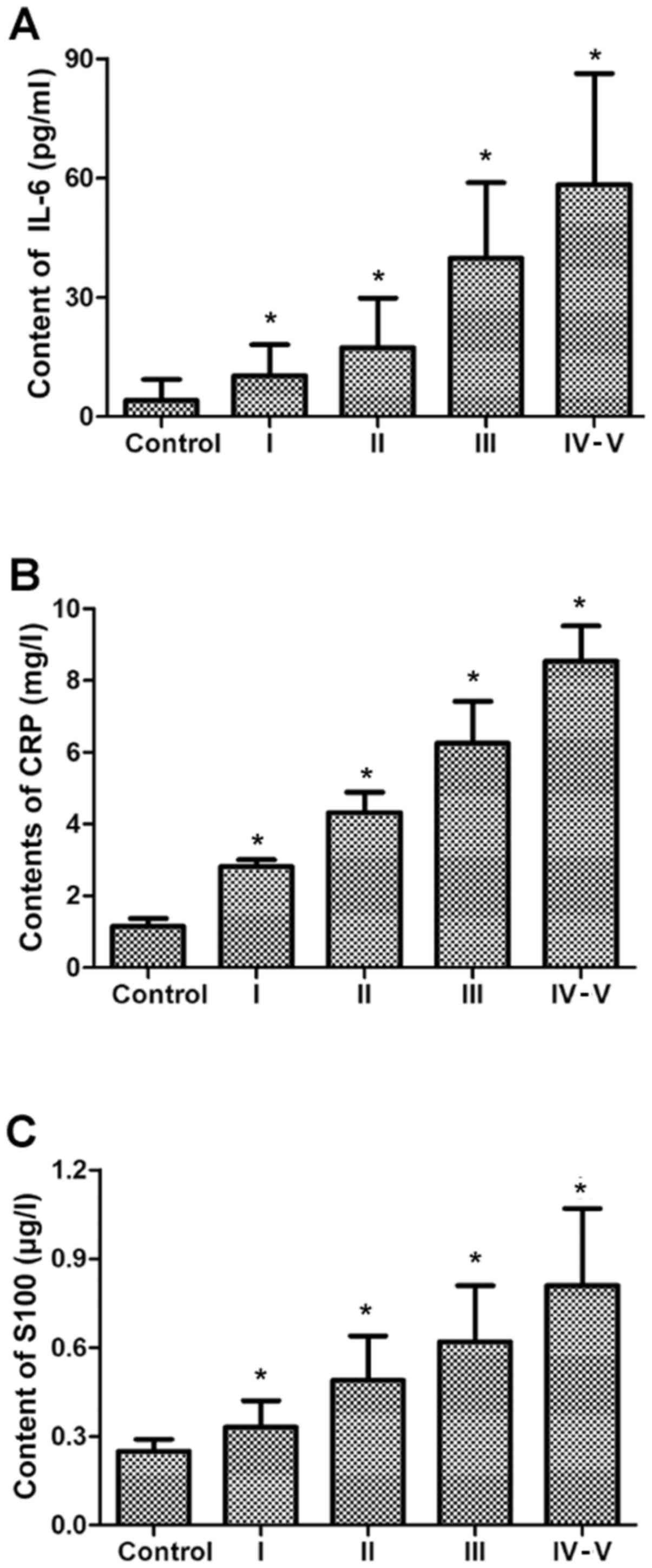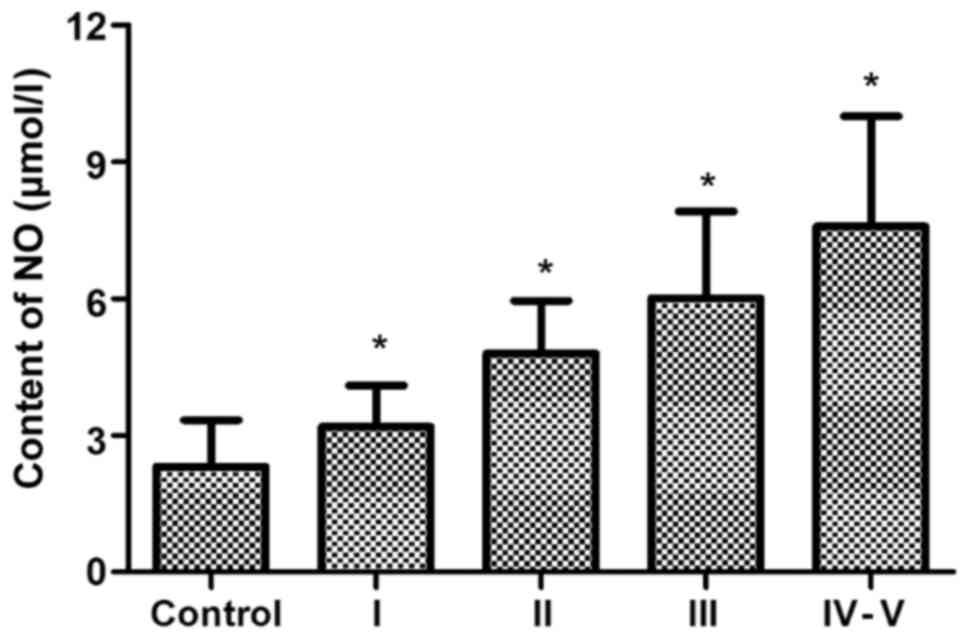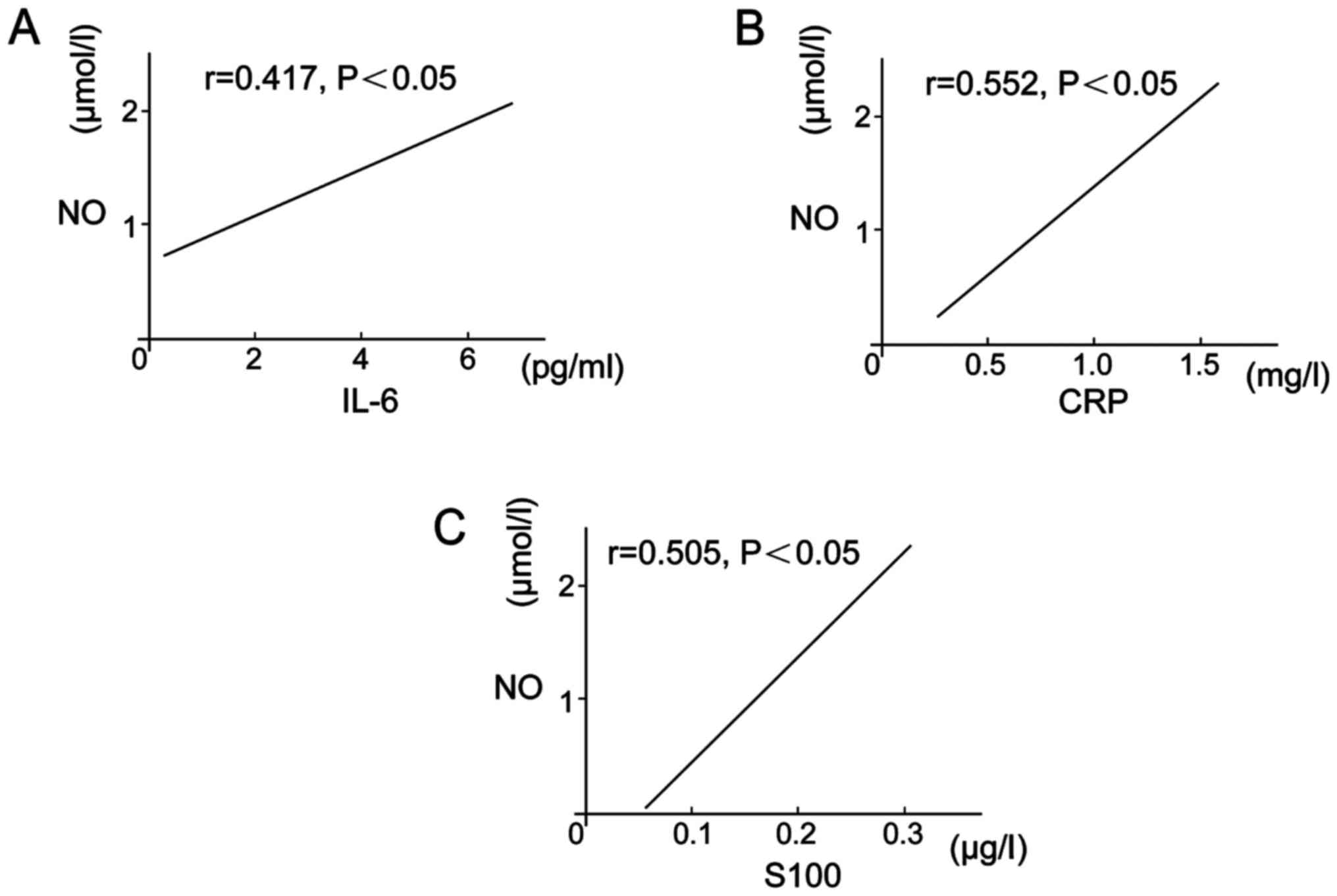Introduction
Subarachnoid hemorrhage (SAH) refers to the syndrome
where the blood reaches the intracranial or intraspinal
subarachnoid space after intracranial vascular rupture caused by
many factors (1). It is reported
that SAH accounts for approximately 15% of cerebrovascular diseases
(2). If there is no effective
clinical treatment in the early stages of bleeding, approximately
13% patients will die suddenly (3,4).
Cerebral vasospasm (CVS) usually occurs after SAH,
and it can cause cerebral infarction in case of severe condition
(5,6), so the early diagnosis of this disease
is particularly important. Increasing number of scholars believe
that SAH is closely related to the body's inflammatory response.
They think that the occurrence and development of SAH are also
associated with the body's cytokine expression (7–10).
In the present study, the changes in interleukin-6
(IL-6), C-reactive protein (CRP) and S100 in serum and NO in
cerebrospinal fluid (CSF) in SAH patients were detected to
investigate the possible pathogenesis of SAH, so as to provide new
directions for the early clinical diagnosis of SAH.
Patients and methods
Patients
A total of 43 patients clinically confirmed as SAH
were selected (Fig. 1), including 27
males and 16 females aged 61±5 years. The clinical data were sorted
by Hunt-Hess grade and the results were evaluated by the
specialist. Exclusion criteria: Patients with the onset time of
more than 3 days, used to receive the clinic treatment in other
hospitals, with liver, kidney, heart or lung insufficiency or
infectious diseases. This study was approved by the Ethics
Committee of Binzhou Medical University Hospital (Binzhou, China).
Signed written informed consents were obtained from all
participants before the study. Control group: 23 healthy subjects
were selected, including 13 males and 10 females aged 58±4 years.
SAH patients were divided into the CVS and the non-CVS groups
according to whether there was CVS, and patients were also divided
into the favorable prognosis and the unfavorable prognosis groups
according to APACHE II score. All patients and healthy subjects
signed the informed consent.
Experimental reagents
Human IL-6, CRP and S100 enzyme-linked immunosorbent
assay (ELISA) kits (Shanghai Genetimes ExCell Biotechnology Co.,
Ltd., Shanghai, China) and NO kit (Wenzhou ERKN Biotechnology Co.,
Ltd., Wenzhou, China).
Detection of IL-6, CRP and S100 in
serum
Human IL-6, CRP and S100 ELISA kits were purchased
from Shanghai Genetimes ExCell Biotechnology Co., Ltd. The
expression levels of IL-6, CRP and S100 in serum samples were
detected according to the instructions.
The contents of IL-6, CRP and S100 were detected
according to the instructions of IL-6, CR and S100 ELISA kit.
Detection of NO level in CSF
The chemical property of NO is more active, which
can be quickly metabolized and converted into
NO2− and NO3−, and
NO2− will be further converted into
NO3−. In this study, the nitrate reductase
method was used to specifically reduce NO3−
into NO2−, the latter of which can react with
the developer and produce colored substances. Finally, the
absorbance value was detected.
The level of NO in CSF was detected according to the
instructions of NO kit.
Statistical analysis
In this study, SPSS 17.0 (SPSS, Inc., Chicago, IL,
USA) software was used for analysis. Data were presented as mean ±
standard deviation. Comparison between groups was done using
One-way ANOVA test followed by post hoc test (Least Significant
Difference). Pearson's analysis was used to test the correlation
between the two factors. α=0.05 was set as the inspection
standard.
Results
Contents of serum IL-6, CRP and S100
in SAH patients
The expression levels of IL-6, CRP and S100 in serum
of SAH patients were significantly higher than those in the normal
control group, and the differences of each Hunt grade were
statistically significant compared with the normal control group
(P<0.05). The expression levels of IL-6, CRP and S100 in serum
of SAH patients were gradually increased with the increase of Hunt
grade (Fig. 2).
Content of NO in CSF
The expression level of NO in CSF of SAH patients
was significantly higher than that in the normal control group, and
the difference of each Hunt grade was statistically significant
compared with the normal control group (P<0.05). The expression
level of NO in CSF of SAH patients was gradually increased with the
increase of Hunt grade (Fig. 3).
Contents of serum IL-6, CRP and S100
and NO in CSF in the CVS and non-CVS groups
The levels of IL-6, CRP, S100 and NO in CSF in CVS
group were higher than those in the normal control group at 1, 4, 7
and 10 days, and the differences were significant. The contents of
serum IL-6, CRP and S100 and NO in CSF in the CVS group were
significantly higher than those in the non-CVS group, and the
differences were statistically significant (P<0.05). The
contents of IL-6, CRP, S100 and NO in CSF in the CVS group were
increased gradually with the extension of time, while the contents
of IL-6, CRP, S100 and NO in CSF in the non-CVS group reached the
peak at 4 days and then gradually declined (Table I).
 | Table I.Contents of serum IL-6, CRP, S100 and
NO in CSF in the CVS and the non-CVS groups (mean ± standard
deviation). |
Table I.
Contents of serum IL-6, CRP, S100 and
NO in CSF in the CVS and the non-CVS groups (mean ± standard
deviation).
| Group | n | Days | IL-6 (pg/ml) | CRP (mg/l) | S100 (µg/l) | NO (µmol/l) |
|---|
| Control | 23 |
| 4.01±5.36 | 1.15±0.22 | 0.25±0.04 | 2.31±1.02 |
| CVS | 25 | 1 |
10.65±4.91a,b |
5.99±1.03a,b |
0.53±0.02a,b |
4.14±0.69a,b |
|
|
| 4 |
29.26±9.49a,b |
13.83±0.95a,b |
0.81±0.14a,b |
5.97±1.16a,b |
|
|
| 7 |
37.93±14.07a,b |
15.17±2.36a,b |
1.03±0.22a,b |
7.82±1.63a,b |
|
|
| 10 |
52.39±20.81a,b |
25.82±4.41a,b | 1.
71±0.14a,b |
8.85±1.07a,b |
| Non-CVS | 18 | 1 |
7.11±4.25a |
3.05±0.27a |
0.39±0.03a |
3.77±0.65a |
|
|
| 4 |
25.94±6.35a |
11.48±1.33a |
0.68±0.08a |
5.31±1.04a |
|
|
| 7 |
22.19±10.31a |
9.29±0.37a |
0.55±0.11a |
4.85±0.97a |
|
|
| 10 |
15.88±8.37a |
6.73±1.29a |
0.51±0.04a |
4.42±0.73a |
Factor contents in favorable prognosis
group and unfavorable prognosis group
Compared with those in the normal control group, the
expression levels of IL-6, CRP, S100 and NO in CSF in unfavorable
prognosis group were higher at 1, 4, 7 and 10 days, and the
differences were statistically significant (P<0.05). Compared
with those in favorable prognosis group, the levels in the
unfavorable prognosis group were significantly higher at 1, 4, 7
and 10 days (P<0.05). The levels of IL-6, CRP, S100 and NO in
CSF in the unfavorable prognosis group were gradually increased,
while the levels in favorable prognosis group reached the peak at 4
days and then declined gradually (Table
II).
 | Table II.Contents of IL-6, CRP, S100 and NO in
CSF in the favorable prognosis and the unfavorable prognosis groups
(mean ± standard deviation). |
Table II.
Contents of IL-6, CRP, S100 and NO in
CSF in the favorable prognosis and the unfavorable prognosis groups
(mean ± standard deviation).
| Group | n | Days | IL-6 (pg/ml) | CRP (mg/l) | S100 (µg/l) | NO (µmol/l) |
|---|
| Control | 23 |
| 4.01±5.36 | 1.15±0.22 | 0.25±0.04 | 2.31±1.02 |
| Favorable
prognosis | 32 | 1 |
6.48±3.13a |
2.94±0.18a |
0.28±0.03a |
3.18±0.47a |
|
|
| 4 |
23.74±5.96a |
10.85±1.48a |
0.55±0.08a |
5.22±0.97a |
|
|
| 7 |
19.86±7.75a |
8.37±0.29a |
0.47±0.05a |
4.77±0.58a |
|
|
| 10 |
13.03±9.16a |
6.15±0.77a |
0.39±0.04a |
3.35±0.26a |
| Unfavorable
prognosis | 11 | 1 |
9.03±3.37a,b |
4.52±0.99a,b |
0.44±0.03a,b |
3.27±0.55a,b |
|
|
| 4 |
28.47±8.59a,b |
13.03±1.25a,b |
0.67±0.16a,b |
4.85±0.94a,b |
|
|
| 7 |
35.14±12.55a,b |
18.74±1.99a,b |
1.33±0.19a,b |
6.69±1.36a,b |
|
|
| 10 |
48.02±17.83a,b |
27.85±2.76a,b |
1.68±0.25a,b |
7.57±1.11a,b |
Correlation among IL-6, CRP, S100 and
NO in CSF
The correlations among IL-6, CRP, S100 and NO in CSF
were detected via Pearson's analysis. It was found that there was a
positive correlation between IL-6 and NO, between CRP and NO and
between S100 and NO (r1=0.417, P<0.05;
r2=0.552, P<0.05; r3=0.505, P<0.05),
and the differences were statistically significant (Fig.4). The expression of IL-6 was elevated
when the inflammatory response occurred, and the contents of CRP,
S100 and NO in CSF were also increased.
Discussion
SAH is a clinical syndrome caused by many factors
with a high mortality rate, which refers to the blood reaching the
intracranial or intraspinal subarachnoid space after intracranial
vascular rupture (11,12). IL-6, as a kind of glycoprotein, can
participate in the collective inflammatory response and
anti-infective defense mechanisms (13,14). At
present, it is recognized that IL-6 is a kind of multi-functional
glycoprotein cell inflammatory factor involved in various
inflammatory reactions of central nervous system, which can cause
immune response to the brain tissue damage and inflammation
(15). CRP can be synthesized after
IL-6 induction, thus activating the body's complement system and
improving the immunity (16,17). Some scholars have pointed out that
CRP can be associated with prognosis as a continuous variable
(18). When SAH occurs, neuroglia
cells will be damaged, thus increasing the S100 protein level.
Therefore, S100 is often used as one of the markers of SAH
(19,20).
In this study, 43 patients diagnosed as SAH were
selected and the levels of IL-6, CRP, S100 and NO in CSF were
detected. The results showed that the expression of IL-6, CRP, S100
and NO in CSF in SAH patients were higher than those in the healthy
normal control group. And the difference of each Hunt grade was
significant compared with the normal control group. The contents of
IL-6, CRP, S100 and NO in CSF in SAH patients were gradually
increased with the increase of Hunt grade. The levels of IL-6, CRP,
S100 and NO in CSF in CVS group at 1, 4, 7 and 10 days were higher
than those in the normal control group. Compared with those in the
non-CVS group, the levels of the four factors in the CVS group were
significantly higher. The levels of IL-6, CRP, S100 and NO in CSF
in the CVS group were increased gradually with the extension of
time, while the levels of IL-6, CRP, S100 and NO in CSF in the
non-CVS group reached the peak at 4 days, and then gradually
declined. Compared with those in the normal control group, the
expression levels of IL-6, CRP, S100 and NO in CSF in the
unfavorable prognosis group were higher at 1, 4, 7 and 10 days.
Compared with those in the favorable prognosis group, the levels in
the unfavorable prognosis group at 1, 4, 7 and 10 days were higher.
The levels of IL-6, CRP, S100 and NO in CSF in the unfavorable
prognosis group were gradually increased, while the levels in the
favorable prognosis group reached the peak at 4 days, and then
declined gradually. The expression levels of IL-6, CRP, S100 and NO
in CSF in SAH patients were generally higher than those in the
healthy normal control group. And the difference of each Hunt grade
was significant compared with the normal control group. The
contents of IL-6, CRP, S100 and NO in CSF in SAH patients were
gradually increased with the increase of Hunt grade. There were
positive correlations among the levels of IL-6, CRP, S100 and NO in
CSF in SAH patients, confirming that IL-6, CRP, S100 and NO in CSF
in SAH patients can reflect the severity and development process of
inflammatory response, and may be involved in the occurrence and
development of disease, late CVS and prognosis.
In conclusion, the levels of IL-6, CRP, S100 and NO
in CSF of SAH patients were detected in this study, and it was
found that there is a positive correlation between each of the two
factors, which can reflect the development process of SAH and has a
certain guiding significance for the clinical diagnosis of SAH.
Acknowledgements
Not applicable.
Funding
No funding was received.
Availability of data and materials
All data generated or analyzed during this study are
included in this published article.
Authors' contributions
WZ designed the study, LS and LM collected the data,
ZL analyzed the data. All authors read and approved the final
manuscript.
Ethics approval and consent to
participate
This study was approved by the Ethics Committee of
Binzhou Medical University Hospital (Binzhou, China). Signed
informed consents were obtained from the patients or the
guardians.
Patient consent for publication
Not applicable.
Competing interests
The authors declare that they have no competing
interests.
References
|
1
|
Srinivasan A, Aggarwal A, Gaudihalli S,
Mohanty M, Dhandapani M, Singh H, Mukherjee KK and Dhandapani S:
Impact of early leukocytosis and elevated High-Sensitivity
C-Reactive protein on delayed cerebral ischemia and neurologic
outcome after subarachnoid hemorrhage. World Neurosurg. 90:91–95.
2016. View Article : Google Scholar : PubMed/NCBI
|
|
2
|
Jeon YT, Lee JH, Lee H, Lee HK, Hwang JW,
Lim YJ and Park HP: The postoperative C-reactive protein level can
be a useful prognostic factor for poor outcome and symptomatic
vasospasm in patients with aneurysmal subarachnoid hemorrhage. J
Neurosurg Anesthesiol. 24:317–324. 2012. View Article : Google Scholar : PubMed/NCBI
|
|
3
|
Jethwa PR, Punia V, Patel TD, Duffis EJ,
Gandhi CD and Prestigiacomo CJ: Cost-effectiveness of digital
subtraction angiography in the setting of computed tomographic
angiography negative subarachnoid hemorrhage. Neurosurgery.
72:511–519. 2013. View Article : Google Scholar : PubMed/NCBI
|
|
4
|
Lee JH, Park JW, Kwon BS, Ryu KH, Lee HJ,
Park YG, Chang JH and Sim KB: Dysphagia due to retropharyngeal
abscess that incidentally detected in subarachnoid hemorrhage
patient. Ann Rehabil Med. 36:861–865. 2012. View Article : Google Scholar : PubMed/NCBI
|
|
5
|
Kellermann I, Kleindienst A, Hore N,
Buchfelder M and Brandner S: Early CSF and serum S100B
concentrations for outcome prediction in traumatic brain injury and
subarachnoid hemorrhage. Clin Neurol Neurosurg. 145:79–83. 2016.
View Article : Google Scholar : PubMed/NCBI
|
|
6
|
Zhuang YT, Xu DY, Wang GY, Sun JL, Huang Y
and Wang SZ: IL-6 induced lncRNA MALAT1 enhances TNF-α expression
in LPS-induced septic cardiomyocytes via activation of SAA3. Eur
Rev Med Pharmacol Sci. 21:302–309. 2017.PubMed/NCBI
|
|
7
|
Zhong W, Zhang Z, Zhao P, Shen J, Li X,
Wang D, Li G and Su W: The impact of initial systemic inflammatory
response after aneurysmal subarachnoid hemorrhage. Turk Neurosurg.
27:346–352. 2017.PubMed/NCBI
|
|
8
|
Shim JH, Yoon SM, Bae HG, Yun IG, Shim JJ,
Lee KS and Doh JW: Which treatment modality is more injurious to
the brain in patients with subarachnoid hemorrhage? Degree of brain
damage assessed by serum S100 protein after aneurysm clipping or
coiling. Cerebrovasc Dis. 34:38–47. 2012. View Article : Google Scholar : PubMed/NCBI
|
|
9
|
Brandner S, Thaler C, Buchfelder M and
Kleindienst A: Brain-derived protein concentrations in the
cerebrospinal fluid: Contribution of trauma resulting from
ventricular drain insertion. J Neurotrauma. 30:1205–1210. 2013.
View Article : Google Scholar : PubMed/NCBI
|
|
10
|
Park J and Lee D: Intraarterial schwannoma
in horizontal segment of middle cerebral artery causing
subarachnoid hemorrhage. J Neurosurg. 118:1069–1071. 2013.
View Article : Google Scholar : PubMed/NCBI
|
|
11
|
Larsen CC and Astrup J: Rebleeding after
aneurysmal subarachnoid hemorrhage: A literature review. World
Neurosurg. 79:307–312. 2013. View Article : Google Scholar : PubMed/NCBI
|
|
12
|
Tykocki T, Kostyra K, Bojanowski K and
Kostkiewicz B: Analysis of the serum components in acute period
after subarachnoid hemorrhage. Turk Neurosurg. 24:672–678.
2014.PubMed/NCBI
|
|
13
|
Galea J, Ogungbenro K, Hulme S, Patel H,
Scarth S, Hoadley M, Illingworth K, McMahon CJ, Tzerakis N, King
AT, et al: Reduction of inflammation after administration of
interleukin-1 receptor antagonist following aneurysmal subarachnoid
hemorrhage: results of the Subcutaneous Interleukin-1Ra in SAH
(SCIL-SAH) study. J Neurosurg. 128:515–523. 2018. View Article : Google Scholar : PubMed/NCBI
|
|
14
|
Liu Y, Wang J, Zhang L, Wang C, Wu J, Zhou
Y, Gao X, Wang A, Wu S and Zhao X: Relationship between C-reactive
protein and stroke: A large prospective community based study. PLoS
One. 9:1070172014. View Article : Google Scholar
|
|
15
|
Alfotih GT, Li F, Xu X and Zhang S: Risk
factors for re-bleeding of aneurysmal subarachnoid hemorrhage:
Meta-analysis of observational studies. Neurol Neurochir Pol.
48:346–355. 2014.PubMed/NCBI
|
|
16
|
Changyaleket B, Xu H, Vetri F, Valyi-Nagy
T, Paisansathan C, Chong ZZ, Pelligrino DA and Testai FD:
Intracerebroventricular application of S100B selectively impairs
pial arteriolar dilating function in rats. Brain Res. 1634:171–178.
2016. View Article : Google Scholar : PubMed/NCBI
|
|
17
|
Romero FR, Cataneo DC and Cataneo AJ:
C-reactive protein and vasospasm after aneurysmal subarachnoid
hemorrhage. Acta Cir Bras. 29:340–345. 2014. View Article : Google Scholar : PubMed/NCBI
|
|
18
|
Lenski M, Huge V, Briegel J, Tonn JC,
Schichor C and Thon N: Interleukin 6 in the cerebrospinal fluid as
a biomarker for onset of vasospasm and ventriculitis after severe
subarachnoid hemorrhage. World Neurosurg. 99:132–139. 2017.
View Article : Google Scholar : PubMed/NCBI
|
|
19
|
Li H, Wu W, Sun Q, Liu M, Li W, Zhang XS,
Zhou ML and Hang CH: Expression and cell distribution of receptor
for advanced glycation end-products in the rat cortex following
experimental subarachnoid hemorrhage. Brain Res. 1543:315–323.
2014. View Article : Google Scholar : PubMed/NCBI
|
|
20
|
Frontera JA, Provencio JJ, Sehba FA,
McIntyre TM, Nowacki AS, Gordon E, Weimer JM and Aledort L: The
role of platelet activation and inflammation in early brain injury
following subarachnoid hemorrhage. Neurocrit Care. 26:48–57. 2017.
View Article : Google Scholar : PubMed/NCBI
|


















